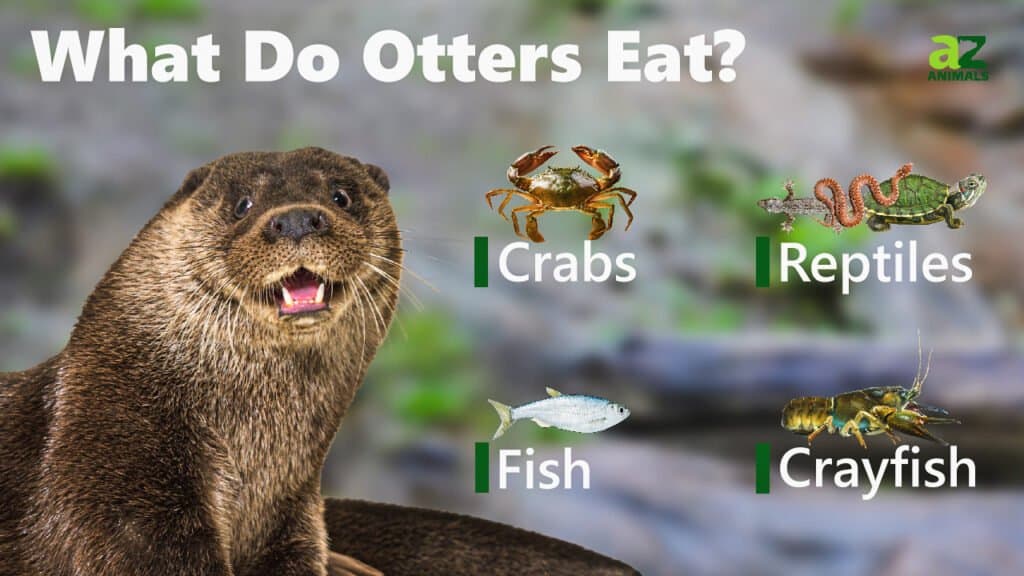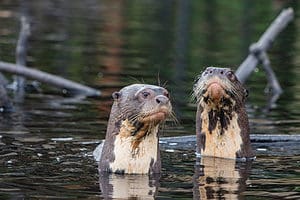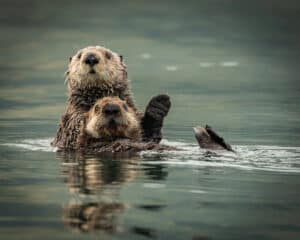Key Facts
- Otters have quite an appetite and love nothing better than seeking their next meal.
- Even though they’re carnivorous, they enjoy quite a bit of variety, and avians, amphibians, or mollusks, might feature on their lunchtime menus.
- Some of them have very handy pouches for carrying leftovers and even tools which they rely on to get to all that succulent goodness concealed within a hard shell.
Highly intelligent, sociable, and just plain fun to watch, the carnivorous otter is an aquatic member of the Mustelid (or weasel) family. Their lithe bodies and webbed toes and feet enable them to glide smoothly through the water and catch prey. There are some 13 species of otters around the world. Most of them are freshwater species, including the North American river otter, the Eurasian otter, the giant otter of the Amazon, the Asian small-clawed otter, and several African species. But the sea otter of the North American Pacific coast and the marine otter of the South American Pacific both spend the majority of their lives swimming and hunting in the ocean. But what do these otters eat?
This article will cover exactly what they eat and how they obtain their food. As some of the most intelligent animals on the planet, the otter’s dietary habits are quite fascinating to read about. However, for the purpose of this article, both river otters and sea otters will be covered differently.
What Does the Otter Eat?

River otters are considered to be generalist carnivores. This means they will eat almost anything they can catch. Some of their favorite foods include fish, crabs, crayfish, frogs, turtles, snakes, and birds and their eggs. However, their diet generally changes quite a bit depending on where they live. Giant otters from the Amazon, which coordinate their hunting in larger groups, are highly dependent on cichlids, catfish, and piranhas; they even hunt the mighty caiman.
The North American river otter, by contrast, relies heavily on crayfish, trout, salmon, and suckers. They do, however, prefer to eat larger fish due to the ease with which the slow-moving prey can be captured. As carnivorous mammals, they consume little if any plant matter in their diets, except for the occasional aquatic plant or root. They spend a lot of time hunting food and burn off much of that energy, leaving little to waste.
These mustelids are actually partial to a bit of natural sweetness. They love apples, berries, cherries, grapes, and tomatoes.
However, their caretakers in zoos or private institutions are required to take special care with fruit seeds as some of them such as apple pips contain cyanide.
Sea/marine otters are equally as voracious. Even though they spend about half the day resting, they need to keep warm and swim often. In order to power their high metabolisms, it’s estimated that they consume around 25% of their body weight every single day. This means a 50-pound otter would need to consume 10 to 15 pounds of food. Since sea and marine otters are found all over the American Pacific coast, it’s difficult to provide exact details about their diet, but some of their favorite foods are sea urchins, sea stars, crabs, squids, clams, mussels, and snails.
Fish represents a smaller part of the diet compared with river otters. By all accounts, sea otters play a vital role in marine ecosystems by controlling prey populations. Too many sea urchins can kill off kelp forests, thus reducing the ecological diversity of the coastal ecosystem. Since hunting sea otters to near extinction, the state of Oregon has seen much of its kelp forest laid to waste by urchins. Fortunately, there are plans to bring sea otter back to restore the kelp ecosystem.
How Does the Otter Hunt and Eat Its Food?
Carnivorous otters have several important adaptations that enable them to hunt in their aquatic environments. The long whiskers are so sensitive that they can find prey along the sandy bottom of the river or ocean even when their other senses may be useless or impaired. Their ergonomic bodies and webbed feet or toes allow them to maneuver exceptionally well in the water so they can lunge at prey over short distances. And their sharp canine teeth help them quickly kill their prey and chew through the meat.
River otters do most of their hunting in freshwater rivers, lakes, and marshes, but they sometimes come up on shore for a quick meal as well. Unless they’re a part of a larger group, the female must provide for her pup alone in the spring and summer, while the male generally hunts for just himself. Fortunately, because of their thick fur (among the thickest of any animal on the planet), they don’t need to store food or hibernate for the winter. They can hunt under the frozen ice and still remain warm and comfortable.
Sea otters, by contrast, do almost all of their hunting in the water and rarely hunt on land. They dive down to the bottom of the shallow coastal shelves and hunt for tiny morsels among the kelp and dirt. They can stay underwater for around five minutes and reach depths of around 200 feet. Their fully webbed hind flippers (which river otters lack) imbue them with incredible swimming skills.
Sea otters are also remarkably clever. These versatile and intelligent creatures are one of the few known animals that use tools to obtain their food. In order to break open the hard shells of small marine invertebrate, the sea otter will set the food on its stomach and smash it open with a small rock. It also has the ability to bash the creature against a larger sheet of rocks. If it has any leftover bits of uneaten food, then the sea otter will store it in the loose skin flaps, known as pockets, located just under each forearm. The pockets also provide a handy storage space for its tools.
A Complete List of the Top 10 Foods the Otter Eats
River and sea otter diets are so different from each other that they need to be divided up into separate lists. Here are the top 10 foods the average river otter eats:
- Fish
- Crayfish
- Crabs
- Clams
- Frogs
- Turtles
- Snakes
- Birds
- Eggs
- Snails
And here’s a list of the top 10 foods consumed by the average sea otter:
- Sea Urchins
- Sea Stars
- Crabs
- Squids
- Clams
- Mussels
- Snails
- Worms
- Fish
- Octopi
Up Next…
Keep reading these posts for more incredible information about key animal facts.
What Do Cats Eat?: What are their favorite foods and how do they hunt? What predators do they need to be wary of? Find out here.
What Do Moose Eat?: Are they accidental carnivores? Do they enjoy variety or simply munch on monotonous fare? Discover those facts and more.
What Do Elephants Eat? Their Diet Explained: Are they strictly vegetarian? Do they have a sweet tooth? Discover what these lovable mammals eat and how much they’re capable of tucking away a day.
The photo featured at the top of this post is © Jonathan Chancasana/Shutterstock.com
Thank you for reading! Have some feedback for us? Contact the AZ Animals editorial team.







